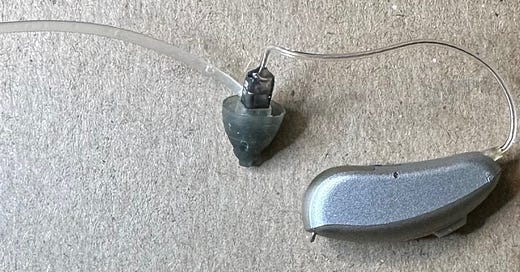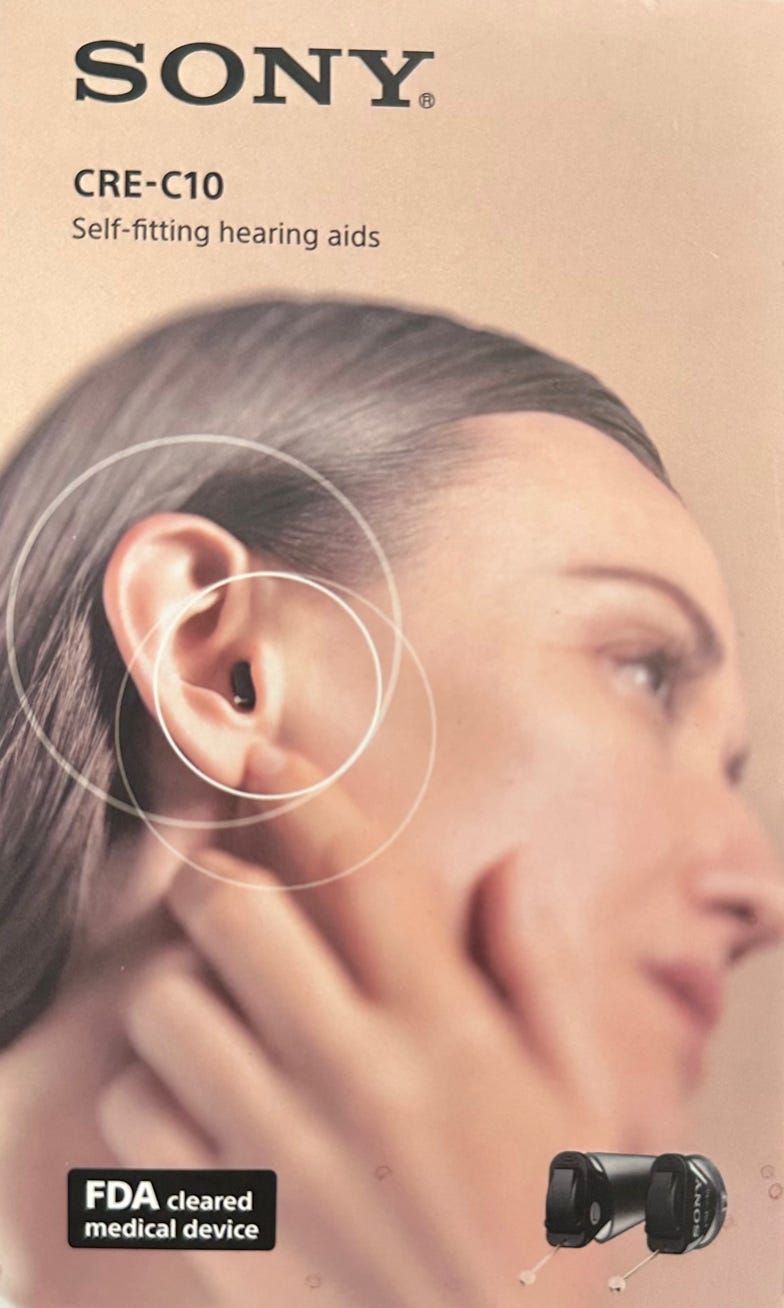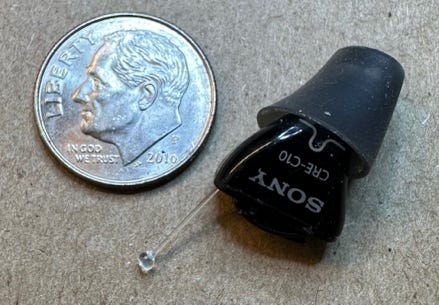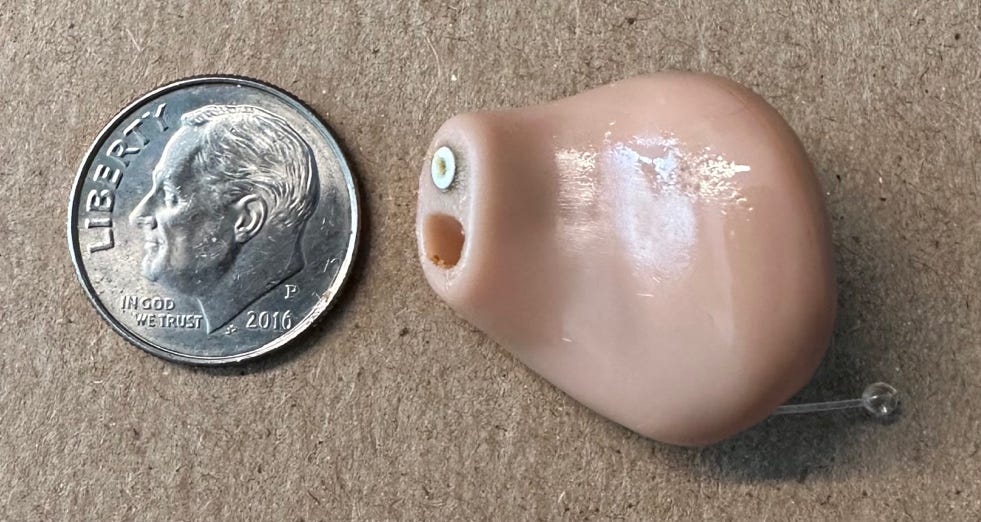OTC Hearing Aids Would be Great If Only…
Retailers stopped selling them like underwear and vendors focused more on the real problems of proper fitment.
I have a beef about OTC hearing aids. From my limited sample, vendors aren’t focusing on usability and value. Seeking maximum market share shouldn’t be the first objective.
I’m involved. I need, have, and have been using hearing aids for almost six years. When the FDA announced its new rules for OTC (Over-The-Counter) hearing aids in 2022, my ears perked up. Something new to supplement, supplant or completely replace my then aging OTE (over-the-ear) aids?
So how’s it going?
Mass Eye and Ear (MEE) audiologists are usually recommending a "self-fitting" OTC ReSound device that the patient can customize at home without professional help for around $800 a pair. While not inexpensive, prescription hearing aids can cost up to about $6,000.
MEE Audiologists are encouraging use of OTC devices for many new patients but business isn't exactly booming, sales volume has been quite low; and in the past 2 months they've sold six pairs, with a 50% return rate.
Source: https://www.medpagetoday.com/surgery/otolaryngology/104711
Let me share my OTC experience and look at the problems I personally encountered.
Hearing Aid Basics
Hearing aids amplify sound in a way that they compensate for a loss of overall hearing sensitivity and specific hearing losses by frequency (like bass and treble adjustments but with finer measures than those broad categories.)
Technically, each aid has:
A microphone (or two)
An amplifier to boost sound volume
Control electronics that adjust the amplifier to compensate for specific audio deficiencies the user has. Typically but not always, hearing losses are most prominent in higher frequency sound so the control electronics would raise overall volume somewhat but amplify more at the high frequencies than the low or mid-range sounds.
A sound-generating device (essentially a diminutive speaker) and, sometimes
A tube to deliver the sound from the speaker into the user’s ear canal.
That’s a description of an over-the-ear or behind-the-ear hearing aid. Everything listed above goes in a little unit that sits behind the top of your ear, between your ear and skull, riding bareback on the ear. The sound-delivery tube attaches to the over-the-ear unit and delivers sound into the ear, passing through a rubber cone that’s held in place with friction/compression between the cone and the ear canal. In some models, there are wires embedded in the tube to drive tiny speakers in the ear canal at the end of the tube
Here’s a picture of one of the two OTE hearing aids I bought from an audiologist in the fall of 2017 at a cost of over $6000 for the pair. At the time, they were highly rated by various sources, including, if I remember correctly, Consumer Reports.
The behind-the-ear part is on the right side of the picture. The tube to the sound-delivery cone in the center of the picture runs to the center of the picture (in this case, there are wires in the sound-delivery tube and the cone contains the speaker – that’s an improvement on the older approach), and, to the left of the cone is a piece of flexible plastic that helps hold the cone in the right place in the ear.
There’s a much finer description of hearing aids and the variety of models here.
These hearing aids worked but not so well that I’d wear them all the time. They served me OK when I went out to the theatre and sometimes to conferences where I was speaking and meeting with clients for 16 or more hours a day.
Then came COVID.
Now picture me wearing those hearing aids on my ears. Plus eyeglasses (which I wear almost constantly). Add a hat (to protect the noggin from more pre-cancerous skin lesions). And add a mask for COVID.
It was almost comical to see.
I couldn’t take my hat off without getting my glasses tangled in the mask elastics and my hearing aids. The process of taking off a coat usually resulted in multiple things falling off my head in a tangle. A veritable rats’ nest on my head.
I was looking forward to experimenting with OTC (Over-the-counter) hearing aids to see if some of the more advanced styles, like what Consumer Reports call ‘Completely-In-The-Canal’ (CIC) hearing aids would work well for me. (I was also looking for better adjustments in directional sound sensitivity.)
Sony’s CRE-C10 OTC hearing aids became available in late 2022 and when I asked, my audiologist was supportive. “Go try them.” So I ordered a pair … at $1100, from BestBuy and received them in early December.
Here’s a picture of the box that puts the devices in context.
It says right there on the box that they’re self-fitting, which I now know means you fit them yourself if you can figure it out and you’re out of luck if you can’t. But I am getting ahead of myself.
The next picture gives you more perspective on the size of these devices. That’s a U.S. dime, a ten-cent piece, the smallest coin currently in circulation in the US.
On the right side of the picture, one of the two Sony hearing aids. The upper part of the Sony device in that picture, the rubber collar that points up and to the right, is what Sony calls the “click sleeve.” Here’s how Sony explains how to insert, fit and adjust your Sony CRE-C10 hearing aids.
Hearing aids should firmly sit like this in your ear canal. They should feel snug and like they won’t fall out with head movement. If your hearing aids feel uncomfortably tight, consider changing to a smaller ear tip. If they feel loose, consider changing to a smaller ear tip.
And, they warn, if the click sleeve is too tight and comes off in the ear canal, go find a doctor to remove it. (I’ll bet that pours some cold water on anyone who was warned in childhood about sticking anything into their ear canals.)
By the way, if you swap out a click sleeve to test another of a different size, Sony advises not reusing the removed sleeve.
Listen to more in this video to get a full picture of the shallow explanations they provide.
You can also go to https://www.sony.com/electronics/support?path=%2Fsupport for more advice from Sony. Enter the product number, CRE-C10, and look for
Find the correct click sleeve size:
Hint: Your hearing aid will arrive with size S (small) click sleeves attached. If these aren’t comfortable, you can switch to one of the other three sizes provided (XS, M, L). Choose a smaller size if the hearing aid is pressing on your ear or a larger size if the hearing aid feels loose or makes a whistling noise. Also, your left and right ears may be slightly different sizes, so feel free to use different size sleeves in each ear.
This isn’t just an issue of comfort, it’s an issue of quality and utility of fit. It’s not just that the instructions are shallow. The problem is hard and the materials provided were inadequate.
Remember, if you swap out a click sleeve to test another of a different size, Sony advises not reusing the removed sleeve. That means you need multiple pairs of sleeves of each size to try to estimate which is the best fit.
Unfortunately, in December, neither Sony nor BestBuy offered any extra small sleeves for sale, and, while Amazon offered them and I ordered a set from them on the 6th of December, they didn’t arrive until the 9th of January, 2023 when I immediately returned them (after returning my Sony hearing aids to BestBuy in the first of three futile attempts to return them.)
But let’s back to the central story:
I decided to do a simple, real-use test, with the installed small sleeves. I couldn’t determine if they were too large, too small, or just right and I wasn’t sure about differences between left and right in terms of my ear size and topology.
But could I get some value from them?
We took the grandkids to a Holiday concert and sing-along at Harvard. It was a snowy day and, walking along to the concert, one of the two hearing aids fell out. I didn’t even notice it until we got to the auditorium. The hearing aid was lost and gone forever in the snowy streets of Cambridge.
In my mind, the kit deficient, the documentation totally useless and the lack of spare sleeves was a contributing factor. If you wear hearing aids, you understand the vagaries of fit – that’s what I had relied on my audiologist to do.
I returned the hearing aid kit (minus the lost aid) to BestBuy via UPS, well within their return window (which they first denied and then agreed.) I waited weeks and heard nothing. BestBuy returned them to me with no indication of why. I chatted online with BestBuy personnel who told me they understood the problem and would take care of it. So I returned them again. And went through the cycle one last time in April-May … only to be told they would provide no refunds because the hearing aid was soiled (worn) and one was missing.
There is no way you can test out a hearing aid without wearing it.
That lame excuse suggests to me they, if they’re serious, they’re reselling used hearing aids, perhaps without indicating they’ve been used. Either that or they’re just coming up with malarkey to push my request for a refund to the side to protect their internal corporate metrics.
OTC hearing aids are a great idea if the user can get them working properly. And that starts with fit! Sony and Sony’s suppliers failed there.
Meanwhile, I went back to my audiologist. He fitted me with some fantastic, completely in-the-canal (ITC) hearing aids from OTICON, model OWN 1 ITC. They’re fitted by taking an impression of your ear canal using a rubber-like compound. And each aid is designed to fit the unique physical characteristics of the specific ear for which it’s being created. One aid of my first OTICON pair (late January this year) was too tight so they recast it. Here’s my right ITC hearing aid.
These don’t fall out. And their acoustic capabilities are phenomenal (not perfect but pretty darned good.) Not OTC and not inexpensive but I wear them 16 hours a day and I’m loving it.
Retailers shouldn’t sell them like underwear (refusing returns if the device has been worn.) Vendors need to make the next generation of OTC hearing aids far easier for the new owner to fit for themselves.







I also have war stories about hearing aids, but will save those for future comments. Ultimately, I found a retailer with in-house audiologists (Costco) that sells fair priced, high quality units, backs them with 180 day return policy, excellent support, and convenience. I was able to try several models, programmed and fitted properly at the store, and ultimately opted for the store brand (white labeled from Phonak) which sounded the best to me. The after-sales support was excellent either in store or by 800 number. And more good news, as a Connecticut resident, which has a law stating that my insurance must equal Medicare coverage, I was 100% reimbursed for the $1,500 pair. These are behind the ear, bluetooth, rechargable, state of the art units.
Now for my market perspective: the go to market model should be OTC+in-store professional support. These do not need to be certified audiologists - which are of limited quantity - but the equivalent of factory or store trained specialists that can help get the right audio programming (provide by an audiologist performed hearing evaluation) and fitment - similar to getting a pair of glasses. Costco is a good example of the full service retailer that can execute this.
And the next market opportunity, from my perspective as an analyst in advanced audio technologies, is for $1,000 bud earphones that can be 'tuned' to hearing preferences - to compensate for hearing loss or just personal preference. These could be bundled with an app that can provide self administered hearing tests or download a program from a professional audiologist. My own case is that over 50 percent of my use time is connected to my phone via bluetooth listening to music, podcasts, audio books, and news. My hearing aids are at the center of my entertainment world.
And finally, I empathize with your mask, hat, glasses, hearing aid conundrum. Hopefully, those days are a bad memory.